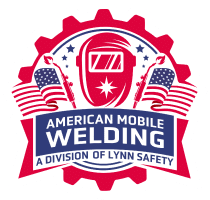Welding Questions
Shielded Metal Arc Welding, commonly called Stick, is a welding process that uses an electrode (welding rod) to carry the electric current and provide the majority of the weld metal. The electrode consists of a core wire coated in flux. An electric arc is created across the gap when the energized circuit and the electrode tip touches the work piece and is withdrawn, yet still within close contact, generating temperatures of approximately 6500°F. This heat melts both the base metal and the electrode creating the weld. During this process, the molten metal is protected from oxides and nitrides in the atmosphere by a gaseous shield created by the vaporizing of the flux coating. The electrode produces a slag covering on the finished weld.
Typical Uses: Steel Erection, Heavy Equipment Repair, Construction, Pipeline Welding
Gas Tungsten Arc Welding, commonly called TIG or Heliarc, is a welding process that uses a non-consumable tungsten electrode to heat the base metal and to create a molten weld puddle. An autogenous (no filler metal) weld can be created by melting two pieces of metal together. An external filler rod can be added into the molten puddle to create the weld bead and increase mechanical properties. Like the GMAW process, the molten weld puddle needs to be shielded by an external gas supply. The most commonly used shielding gas is argon, but argon/helium mixtures can be used on heavy aluminum. GTAW can be used to weld most alloys.
Typical Uses: Aerospace welding, piping systems, vehicles, motorcycles or bikes
Resources:
What is TIG Welding? (GTAW)
Gas Tungsten Arc Welding
Gas Metal Arc Welding, commonly called MIG welding, is a process that uses a continuously fed, solid wire electrode through a welding “gun.” The operator pulls a trigger on the welding gun, which feeds the consumable electrode through. An electric arc forms between the electrode and the base material, which heats the base material, causing it to melt, and join. The molten weld metal is protected from oxides and nitrides in the atmosphere by an externally supplied shielding gas. The most commonly used gas is carbon dioxide or a mixture of argon and carbon dioxide. The GMAW process can be used to weld a wide range of alloys including carbon steel, stainless steel, magnesium, nickel, copper, silicon bronze and aluminum.
Typical Uses: Small to Large Manufacturing, Auto Body, Fabrication
Resources:
What is MIG Welding? (GMAW)
Gas Metal Arc Welding
Flux-cored Arc Welding is a welding process similar to GMAW, in that it uses a continuously fed electrode, but uses a tubular wire filled with flux instead of a solid wire. There are two types of flux-cored wire, self-shielded and dual shield. Self-shielded is used without the aid of an external gas shield and uses the flux to shield the molten weld puddle. Dual shield uses the flux and an external shielding gas to protect the molten weld puddle. Typical shielding gases are carbon dioxide and argon/carbon dioxide mixes. Self-shielded wires are optimal for outdoor use, even in windy situations. Both wires produce a slag covering on the finished weld.
Typical Uses: Thick materials, Steel Erection, Heavy Equipment Construction or Repair
Resources:
Arc Welding
Plasma cutting is a process that cuts through electrically conductive materials by means of an accelerated jet of hot plasma. Typical materials cut with a plasma torch include steel, aluminum, brass and copper, although other conductive metals may be cut as well. Plasma cutting is often used in fabrication shops, automotive repair and restoration, industrial construction, salvage and scrapping operations. Due to the high speed and precision cuts combined with low cost, plasma cutting enjoys widespread use from large-scale industrial CNC applications.
Resources:
Plasma Cutting for Beginners, Plasma Tips and Tricks
What is Plasma Cutting?
Every welding job’s requirements are different, but we often grind the welds, polish the welds, descale the welds, prepare the welded surfaces for painting, and prime the prepared surface after the welding process is completed—all based on individual customer requirements.
We provide welding services for both common and more exotic metals. Our welders have years of experience working with the materials listed below:
– Aluminum
– Chrome Moly
– High Carbon
– Low Carbon Steel
– Stainless
If your project requires a different material that is not listed above, please give us a call and we will work with you towards a welding solution.
Welding is a serious profession with no small amount of danger involved. However, everyone needs to be able to laugh at themselves no matter how dangerous their job. Here are a couple of good humor ways to assess if you are talking to a welder:
– They use a welding rod for chop sticks.
– They are sunburnt in winter.
– Their shirts, sneakers, and socks are ventilated.
– You find that they flick their head down when the sun gets in their eyes.
– They keep feeling for a knob on the back of their baseball cap.
– You say, “It’s Miller time!” and they grab their gloves and shield.
– They lay z-weave ketchup beads on their eggs or French fries.

 American Mobile Welding is your on-call welding specialist.
American Mobile Welding is your on-call welding specialist.
